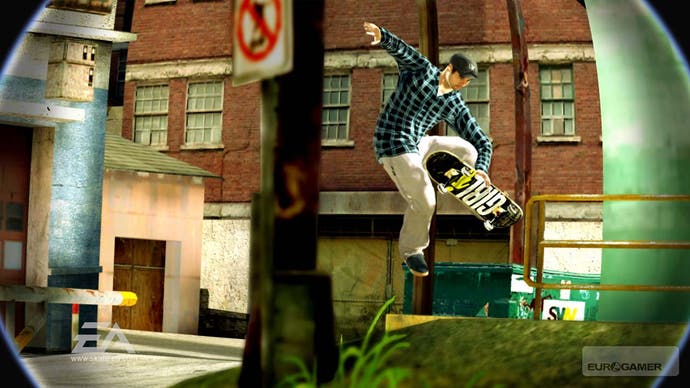Skate 2
Falling down.
Mild-mannered and clever, Skate was probably the most Canadian game ever made, and aside from the new fully-fledged Hall of Meat, the sequel chooses not to pile on disparate distractions and unlikely new directions, but instead working out how best to get more out of the existing framework. There are new elements, then, but they tend to be modest and obvious additions to the experience. "With skate we were building an engine, a team, and a game at the same time," explains DeLong. "Now we have all that in place we're able to simply improve on all the different aspects."
So while Skate 2 features double the moves of the original, it does it all without bringing sweeping change to the existing Flickit system. By making simple additions, like allowing you to take your feet off the board in mid-air, or giving you the opportunity to perform grabs with either hand while grinding, you can recombine the existing flips and shuvits, and perform footplants and fingerflips and various other moves which, to me, sound like enemies from a Rare game.
Then there's the "grab the world" button. By squeezing R1 (or RB on a 360 - the demo was running on a PS3), you can reach out and grasp onto the environment at any point. For tricking, it has obvious benefits: you can now perform extremely satisfying handplants at the top of a ramp, for example, but besides adding another layer to your moves, it opens up much wider possibilities.
And that's because, at the press of a button, you can now come off the board, allowing you to navigate the environment more quickly, or eject from a trick in mid-air if it looks like it's going seriously wrong. You can even jump off your board as it goes under a table, run over the table, and get back onto the board at the other end, a move which has apparently had every journalist who's seen it talking about Back to the Future (and rightly so).
But, more importantly, combined with grabbing, it allows you to set up your own assault courses. "If an object's not bolted down, you can probably move it," says DeLong, and with over 100 bits of in-game furniture ranging from bins to benches to picnic tables, a large portion of Skate 2 is now handed over to the joys of iteration, as you tweak elaborate layouts to get a line just right. In its exactness, it's a mode that speaks to your inner shut-in, and although the physics engine means that if you bump into a ramp you've just positioned you may knock it out of careful alignment, you can now add objects to a session marker, and one button press will snap everything back in place.

Elsewhere, the developers have been enlarging Skate's world, redesigning the city, adding new areas, and creating an entire mountain that was visible in the original game only as a backdrop. "The original San Vanelona could be a bit flat," admits DeLong, while showing off the new wealth of rocky terrain. "Now there's a lot more height to explore." The increased verticality sets the scene for super-speedy downhill races, which have a distinctly SSX feel to them (unsurprisingly, as it turns out: team members from the original SSX now work on Skate). And the races add a new thrill to a game which is often about standing around in a car park, tirelessly mastering a single move: taking a corner at speed as two competitors wipe out into a low-hanging tree and the sun flares a cold golden light across the screen makes you think Skate 2 might be rather special.
There's no word on multiplayer modes yet, other than tantalising hints at much greater crossover between online and single-player, so we'll have to wait on that front. Otherwise, this isn't a sequel that's going to flatten you with an audacious revolution, but it's looking self-assured, graceful, and balanced - qualities that any skater would probably appreciate.

